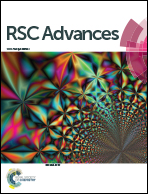Charges on nano-islands and fibrils of poly(3-hexylthiophene-2,5-diyl) – light-modulation, injection and transportation†
Abstract
The impact of the nanostructures of conjugated polymers on their electronic properties is significant. We notice that poly(3-hexylthiophene-2,5-diyl) (P3HT) can form nano-islands and nano-fibrils, and both of them show an similar single-layer thickness (∼1.5–1.6 nm) as evaluated by atomic force microscopy (AFM). The Raman spectra indicate the highest degree of chain planarity and crystallinity in the nano-islands. By using scanning Kelvin probe microscopy (SKPM) and electrostatic force microscopy (EFM), we image the surface potential at the nanometer scale and quantitatively estimate the charges on these nanostructures as modulated by light. Both results are consistent with each other: the surface potential increases on switching on the light, and the photo-induced charges are around 15–25% and positive. A similar amount of the photo-induced charges in both P3HT islands and fibril is consistent with the π–π stacking nature of these nanostructures. As P3HT is a hole-conducting molecule, positive charges are found easily injected into a single island by a positively biased EFM tip, and then the injected charges are able to propagate all over the island.


 Please wait while we load your content...
Please wait while we load your content...